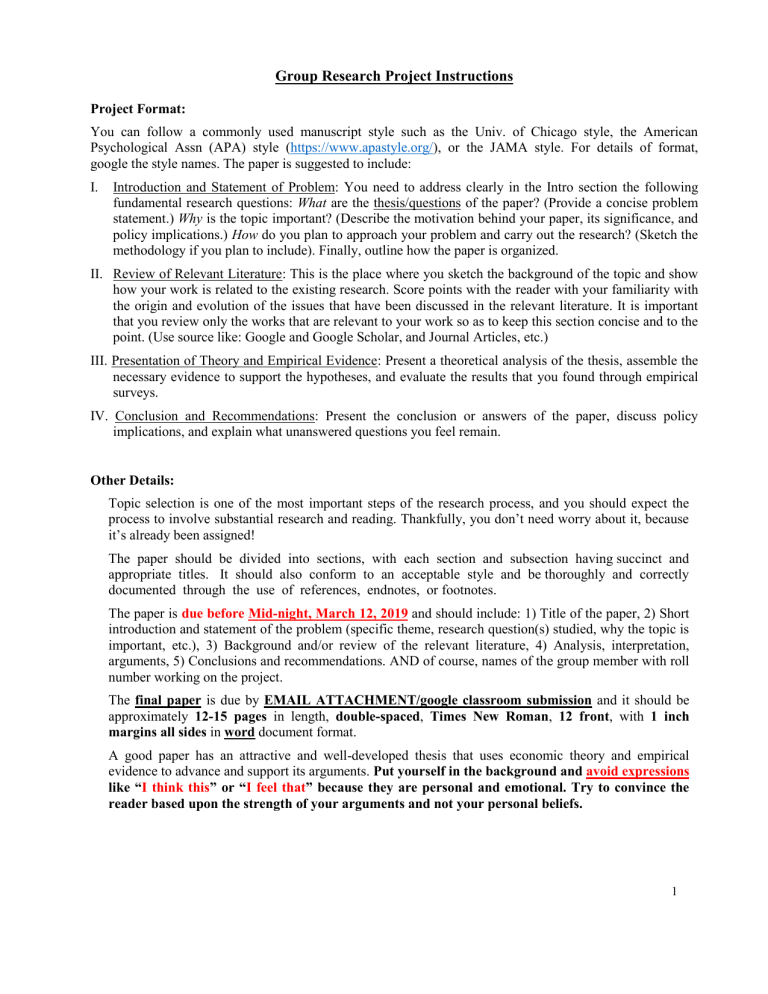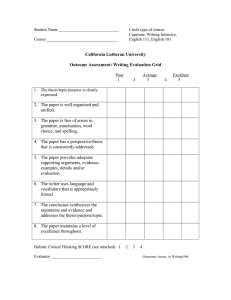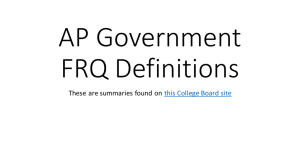
Group Research Project Instructions Project Format: You can follow a commonly used manuscript style such as the Univ. of Chicago style, the American Psychological Assn (APA) style (https://www.apastyle.org/), or the JAMA style. For details of format, google the style names. The paper is suggested to include: I. Introduction and Statement of Problem: You need to address clearly in the Intro section the following fundamental research questions: What are the thesis/questions of the paper? (Provide a concise problem statement.) Why is the topic important? (Describe the motivation behind your paper, its significance, and policy implications.) How do you plan to approach your problem and carry out the research? (Sketch the methodology if you plan to include). Finally, outline how the paper is organized. II. Review of Relevant Literature: This is the place where you sketch the background of the topic and show how your work is related to the existing research. Score points with the reader with your familiarity with the origin and evolution of the issues that have been discussed in the relevant literature. It is important that you review only the works that are relevant to your work so as to keep this section concise and to the point. (Use source like: Google and Google Scholar, and Journal Articles, etc.) III. Presentation of Theory and Empirical Evidence: Present a theoretical analysis of the thesis, assemble the necessary evidence to support the hypotheses, and evaluate the results that you found through empirical surveys. IV. Conclusion and Recommendations: Present the conclusion or answers of the paper, discuss policy implications, and explain what unanswered questions you feel remain. Other Details: Topic selection is one of the most important steps of the research process, and you should expect the process to involve substantial research and reading. Thankfully, you don’t need worry about it, because it’s already been assigned! The paper should be divided into sections, with each section and subsection having succinct and appropriate titles. It should also conform to an acceptable style and be thoroughly and correctly documented through the use of references, endnotes, or footnotes. The paper is due before Mid-night, March 12, 2019 and should include: 1) Title of the paper, 2) Short introduction and statement of the problem (specific theme, research question(s) studied, why the topic is important, etc.), 3) Background and/or review of the relevant literature, 4) Analysis, interpretation, arguments, 5) Conclusions and recommendations. AND of course, names of the group member with roll number working on the project. The final paper is due by EMAIL ATTACHMENT/google classroom submission and it should be approximately 12-15 pages in length, double-spaced, Times New Roman, 12 front, with 1 inch margins all sides in word document format. A good paper has an attractive and well-developed thesis that uses economic theory and empirical evidence to advance and support its arguments. Put yourself in the background and avoid expressions like “I think this” or “I feel that” because they are personal and emotional. Try to convince the reader based upon the strength of your arguments and not your personal beliefs. 1 THE ESSENTIALS OF A GOOD GROUP PROJECT Santerre and Neun (2013): A good research project/paper must have a well-developed thesis or hypothesis. A thesis is a position, or proposition, that you intend to substantiate or prove with theory and facts, or test in the paper through the use of economic theory, data and econometrics. A strong research paper must be well-researched. Although it is difficult to establish the exact number of references a good paper usually cites, it is difficult to imagine a good paper with less than ten sources. When you do your research, be sure to access textbooks, books, economic journals, current periodicals and newspapers. Begin your paper with an INTRODUCTION. It should be approximately 2-3 pages in length and its purpose is to outline what you intend to accomplish in the paper. A clear concise statement of your hypothesis is a must. The importance of the question or hypothesis should be made clear at this point. (Perhaps, some telling statistics bearing on the issue can be cited.) In addition, briefly explain your methodology and conclusions at the end of this section. Remember, you are not writing a mystery novel, so don't be afraid to tell the reader what you intend to accomplish and how you intend to do it. The second section, LITERATURE REVIEW, provides a review, synthesis and critique of the previous literature surrounding the hypothesis under investigation. You should explain how your paper fits in with the previous literature and discuss the novelty of your contribution. The third section, HYPOTHESIS TESTING, should be the main body of the paper, and it is here where you specify and develop your empirical model or arguments to substantiate your thesis. You should draw on the economic theory and empirical findings discussed in class, or which you uncovered during your research from prior studies, to provide the theoretical underpinnings for your empirical model or argument. It is very important that you logically develop your arguments so you do not contradict yourself. It is equally important that you are careful in the use of theory. The worst mistake you can make is to misrepresent known theory. Finally, if assumptions are needed then be bold - make them! When you write this section avoid using the first person. You are trying to persuade the reader based upon economic theory and empirical evidence, and not upon your personal convictions. A paper which states 'I think' this or 'I feel' that is too personal and emotional. Try to convince the reader based upon the strength of your arguments and not your personal beliefs. This section should be about ten pages long. The last section of the paper is the CONCLUSION and should be about two pages in length. Here you sum up the arguments and discuss the (policy) implications of your research. The grade that you receive is based primarily on how well you develop and substantiate your thesis, and not on whether I agree or disagree with your conclusions. An "A" paper is one that has a welldeveloped thesis that uses economic theory and empirical evidence to advance and support its arguments. Lastly, make sure that you just end up doing a “cut-copy-paste” job! Plagiarism would be checked for each group/individual paper. There would be academic dishonesty charge against found guilty. Be aware…… 2


